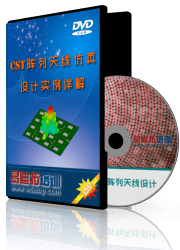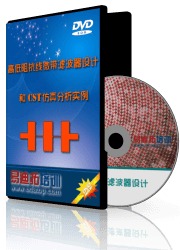- 易迪拓培训,专注于微波、射频、天线设计工程师的培养
Phased Array - CST2013 MWS Examples
Transient Analysis Examples - Antennas
General Purpose Hexahedral: | |
General Purpose Tetrahedral: | |
Transient: |

General Description
In this example a frequency domain calculation is presented in connection with periodic boundary conditions. An antenna array of infinite extent is considered. Each element is fed by the fundamental TE mode through a rectangular waveguide.
The structure has been simulated with the general purpose hexahedral and tetrahedral frequency domain solvers. The results are also compared for an array of 5x5 waveguides with the time domain solver.
Structure Generation
The structure is created by defining a perfectly conducting brick, to which the 'shell' operation is applied. Thus the brick becomes a rectangular waveguide. The front face of the waveguide is extruded and the resulting solid is moved into a dielectric layer.
Additional space is added in front of the waveguide in order to model open space.
For the time domain calculation, the structure is multiplied to a 5x5 array using the translation transform.
Mesh Settings (General Purpose Hexahedral Solver)
The mesh type was set to "Hexahedral Mesh" in the frequency domain solver dialog.
Solver Setup
The frequency range's lower and upper limit are set to 3 GHz and 4 GHz, respectively.
At 3 Ghz, e, h and farfield monitors are defined.
For the frequency domain calculations, the x boundaries are set to periodic with a phase shift of 60 degree, y with zero degree. The z boundaries are set to open. At the lower end of the antenna, a waveguide port is defined.
With the number of frequency steps set to one, the fields at 3 GHz are calculated.
For the time domain calculation, the boundaries are set to open and 25 ports have to be defined. The ports are simultaneously excited with a phase shift of 60 degree in x direction and no shift in y direction.
Post Processing
Three field monitors at 3 GHz are calculated and assigned to the result tree:
2D/3D Results  E-Fielde-field (f=3)[1]
E-Fielde-field (f=3)[1]
2D/3D Results  H-Fieldh-field (f=3)[1]
H-Fieldh-field (f=3)[1]
Farfields  farfield (f=3)[1]
farfield (f=3)[1]
It is observed that the near fields resemble a portion of a plane wave whose phase fronts are rotated when the phase shift of the periodic boundary changes. Thus, the antenna array's pencil beam can be used for scanning a sector of the xz-plane, if one modifies the phase shift of the corresponding periodic boundary condition, with the phase shift in y-direction set to zero.
For the frequency domain simulations, the farfield array feature is activated in the farfield plot dialog using a 5x5 array with 60 degree phase shift in x direction. Looking at the polar plot over theta at phi=0, we can see the main lobe direction at a theta value of approximately minus fifteen degree.
The time domain calculation confirms the farfield results for the 5x5 array. To compare the farfield results in one plot, click on one of the folders
1D Results  Farfield Cartesian dB
Farfield Cartesian dB
1D Results  Farfield Polar Linear
Farfield Polar Linear
in the time domain project.
CST微波工作室培训课程套装,专家讲解,视频教学,帮助您快速学习掌握CST设计应用
上一篇: PEC Sphere - CST2013 MWS Examples
下一篇: RJ45 Connector - CST2013 MWS Examples
CST中文视频培训教程 | More...
 最全面、最专业的CST微波工作室视频培训课程,可以帮助您从零开始,全面系统学习CST的设计应用【More..】
最全面、最专业的CST微波工作室视频培训课程,可以帮助您从零开始,全面系统学习CST的设计应用【More..】
频道总排行
- Rectangular Waveguide Tutorial
- FSS: Simulation of Resonator
- CST2013 MWS Examples: Thermal C
- Dipole Antenna Array - CST201
- CST MWS Examples - CST2013 M
- Microstrip Radial Stub - CST2
- Dielectric Resonator Antenna -
- Interdigital Capacitor - CST20
- CST2013 MWS Examples: Biological
- Lossy Loaded Waveguide - CST2











 沪公网安备 31011202014168号
沪公网安备 31011202014168号
 1427313829
1427313829 旺旺在线
旺旺在线 Skype Online
Skype Online 13761612886
13761612886 官方淘宝店
官方淘宝店
